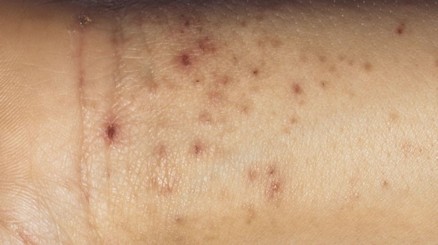Parasitosis due to Sarcoptes scabei hominis (mites) that cause a very itchy and contagious dermatosis. The female digs a gallery in the epidermis (between the stratum corneum and the Malpighi layer) and deposits feces and/or eggs (1-3 per day) in it. About 10% of the eggs float to the skin surface and give adults in 10 to 20 days, after several moultings. The duration of life of Sarcoptes scabei in humans is from 1 to 3 months; outside of its host, it survives only 1 or 2 days because it needs heat and humidity.
The parasite is transmitted by direct (from one individual to the other) or indirect (laundry, infested surfaces) contact. Some forms of scabies, (as the crusty or norwegian or hyperkeratotic scabies) are more contagious and occur in immunocompromised individuals.
Clinical presentation:
- 8 to 15 days incubation
- mostly nigthtime itching
- skin lesions: interdigital folds, anterior parts of the wrists and elbows, navel, genitals, folds of the breasts and buttocks
- these lesions arise as fine grooves, sometimes blisters or scaly plates
- after effective treatment, the presence of dead mites causes itching that persists for several weeks

Treatment:
- local treatment: benzoate benzyl (Ascabiol®) as skin lotion, 1 application at night to maintain contact during 12 (child) to 24 h (adult); or lindane (in cream) 1 application at night to maintain contact during 6 (child if > 10 years) to 12 hours (adult): medications containing lindane are contraindicated in premature babies and people who have experienced seizures and must be used with caution in infants, children, elderly patients and people with skin diseases (for example, atopic eczema, psoriasis), and anyone weighing less than 50 kg because it is a neurotoxin that interferes with neurotransmission at the level of GABAA receptors
- systemic treatment: a dose of ivermectin 200 µg/kg by mouth (Stromectol®), if > 15 kg
- in case of profuse scabies, local and systemic treatments should be combined and repeated after 8 to 15 days
- in babies: essential oil of Melaleuca alternifolia (New Zealand tea tree)
- contaminated clothing should be washed at 60 ° C and sprayed with piperonid butoxide (A-PAR® spray) or pyrethrinoids ( Spregal® spray)
Anesthetic implications:
risk of contagion (gloves !); in case of neuraxial block, avoid puncturing the skin in an infected area; in case of neuraxial block, avoid skin puncture in an infested area
References :
- Ng H-P.
Uncommon cause of itchy back in prengnancy.
Anaesthesia 2003; 58: 399-400
- Kuczkowski KM.
Scabies: a differential diagnosis of pruritus following subarachnoid opioid administration.
Anaesthesia 2003; 58: 1140-1.
- Lee K, Heresi G.
Norwegian scabies in a patient with Down syndrome.
J Pediatr 2019, in press
Updated: March 2019